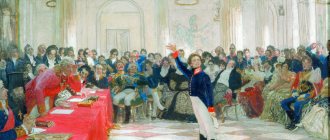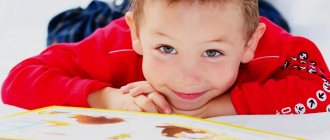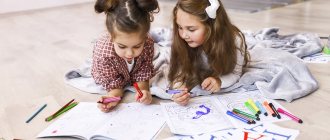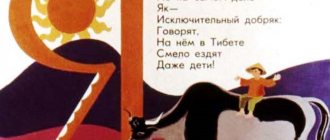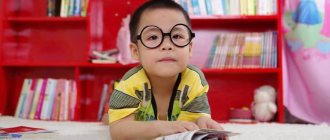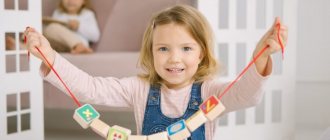At what age should you start learning to read?
There is no consensus on when it is best to start classes - every parent or teacher has their own thoughts on this matter. However, most experts recommend starting to learn to read no earlier than 5 years of age. By this age, the necessary abilities are already formed - the ability to remember, reproduce in memory and recognize various symbols.
But age is far from the only indicator of readiness to learn. Therefore, it is important to make sure that he already has all the necessary abilities.
Initial reading and writing skills of children of senior preschool age, taking into account the Federal State Educational Standard
Gulnur Valeeva
Initial reading and writing skills of children of senior preschool age, taking into account the Federal State Educational Standard
Initial reading and writing skills of children of senior preschool age, taking into account the Federal State Educational Standard for Preschool Education
Inability to read or slow (letter by letter) reading is a serious problem when teaching a child at school. In addition, it is more difficult for a seven-year-old child to master reading than a six-year-old child. But before you start reading, the child must learn to hear what sounds words are made of, that is, learn to conduct a sound analysis of words. It turns out that between the ages of 2 and 5 years, children are very interested in studying the sound component of speech. You can take advantage of this interest and introduce the child to the wonderful world of sounds and thus lead him to reading by the age of six.
The structures responsible for reading abilities evolve along with general language abilities. Recently, their “rejuvenation” has been observed. And a large number of children begin to learn to read under the guidance of incompetent mentors - relatives, older schoolchildren, teachers.
Currently, the “market” of pedagogical services has become very diverse, but to a certain extent spontaneous. For example, many original programs and methodological developments have appeared for teaching literacy to preschool children, and not always of high quality. Some compilers of educational programs, as well as teachers and parents who are not familiar with the patterns of development of written speech, make serious methodological errors. For example:
- They confuse the concepts of “sound” and “letter”, which complicates the processes of sound-letter analysis and synthesis;
— There is an arbitrary and chaotic acquaintance with letters without taking into account the patterns of development of their phonemic names (sounds) and especially violations of this development in some children. Age-related and functional phonetic-phonemic deficiencies (deficiencies in sound pronunciation and sound discrimination) lead to distortion, substitutions, omissions of sounds when reading and complicate the perception of text;
— The names of consonant letters are given to preschoolers in alphabetical transcription [BE, EM, KA, EL], which can only be allowed after the child clearly distinguishes the concepts of “sound” and “letter.” This kind of work is carried out in speech therapy groups and, of course, at school. Or the names of consonants are given with the overtones [SE, KE]. Both of these lead to the corresponding reproduction of the phonetic series of the readable word [EMAEMA] or [MEAMEA] instead of the word MAMA, [SETEULE] instead of the word CHAIR;
- Orthoepic grammar is not used, the introduction of which into the process of sound-letter analysis allows you to read according to the rules of orthoepy (TOOTH - [ZUP], Lump - [KAMOK], ZHIL - [ZHYL].) and prevents errors such as deafening-voicing, unstressed positions of vowels, variations of hardness-softness, etc.
With such literacy training, even children with developed phonemic hearing involuntarily experience a disruption in the reading process, and their reading interest drops sharply. Retraining such “readers” at school creates discomfort in literacy lessons and reduces their effectiveness.
Thus, observations of children’s natural interest in letters indicate the need for literacy training in older preschool age. But this requires appropriate knowledge from preschool teachers and children’s parents.
Let's remember:
1. Sounds - we hear and pronounce sounds.
2. Vowel sounds are sounds, when pronounced, the air stream comes out freely, neither lips, nor teeth, nor tongue interfere with it, therefore vowel sounds can sing. They sing (voice, voice, can sing any melody. For vowel sounds, we came up with “houses” in which they will live. We decided that vowel sounds will live only in red houses (red circles or squares).
3. Consonant sounds are sounds during the pronunciation of which the air stream encounters an obstacle. It is either her lips, teeth, or tongue that prevent her from coming out freely. Some of them can sing (SSS, MMM), but none of them can sing, but they want to sing. Therefore, they AGREE to be friends with vowels, with which they can also sing any melody (ma-ma-ma.). That's why these sounds were called CONSONANT sounds. We also came up with “houses” for consonants, but we decided that they would be blue for hard consonants (blue circles or squares), and green for soft consonants (green circles or squares).
4. Consonant hard sounds [P, B, T, D, M, K, G,. ] - the words sound angry (firm).
5. Soft consonant sounds [ПП-П', ББ-Б', Т-Т', Дь-Д', ММ-М'. ] - the words sound affectionate (soft).
6. The sounds [Ш, Ж, Ц] are always hard, they do not have a “soft” pair (no “gentle” brothers).
7. The sounds [Ch, Shch, Y] are always soft, they do not have a “hard” pair (there are no “angry brothers”).
To master the initial skills of reading and writing, a certain readiness of the sensorimotor and intellectual sphere of children is required. The most important component of preschoolers’ successful work in mastering literacy is the development of phonemic awareness. Since literacy training is based on speech hearing, phonemic perception and the skills of sound and then sound-letter analysis, there is a need for earlier identification of phonemic hearing deficiencies in children and organization of systematic work on its development.
In children aged 3 to 5 years, increased sensitivity to the sound side of speech is observed. In the future, such receptivity is lost, which is why it is so important at this age to develop phonemic hearing and speech perception, and not immediately offer letters that belong to another linguistic reality - the sign system.
That is, when learning to read and write, it is necessary to have a pre-letter, purely sound period of learning, which will go through a number of stages: from the ability to distinguish sounds (both speech and non-speech) to sound analysis and synthesis. That is, before starting to read, a child must learn to hear what sounds words are made of, conduct a sound analysis of words (name in order the sounds that make up words).
Children must comprehend a certain system of patterns of their native language, learn to hear sounds, distinguish between vowels (stressed and unstressed, consonants (hard and soft), compare words by sound, find similarities and differences, divide words into syllables, compose words from syllables, from sounds. Later learn to divide the speech stream into sentences, sentences into words, and only after that become familiar with the letters of the Russian alphabet, mastering the syllable-by-syllable and then continuous reading method.
Thus, work on preparing preschool children for learning to read and write should begin with young children, with the development of their auditory attention, and end with the formation of initial skills in sound-letter analysis in children of older preschool age, that is, initial learning to read and write in printed letters.
In addition, recently, among children attending general education groups of kindergartens, there has been a sharp increase in the number of children with speech disorders, especially with FPSD (phonetic-phonemic speech underdevelopment). In these children, in addition to impaired sound pronunciation, there is a pronounced underdevelopment of phonemic hearing.
These children have the so-called primary phonemic hearing, which provides them with understanding of speech and everyday communication, but is insufficient for the development of its higher forms necessary for dividing the sound stream into words, words into their constituent sounds, and establishing the order of sounds in a word. These children are not ready to perform special mental actions to analyze the sound structure of a word. The phonemic awareness of such children urgently needs to be consistently developed, starting from a young age.
Children from 5 to 6 years old.
Develop the phonemic side of speech. Determine the length of words (measure the syllabic structure of words with claps, steps). You can enter the term “syllable” and make a graphical record of syllabic division. It is necessary to continue to highlight given sounds in words, select words for certain sounds, and isolate the first sound in a word.
The ability to isolate sounds in words helps children analyze the sound composition of words. And this is already the first stage of learning to read and write and a prevention in the future from missing letters when writing. Introduce the term “vowel sound” and its designation with red chips, then the term “consonant sound” with its division into “hard consonant sound” and “soft consonant sound” and designating them with blue and green chips (signals), respectively. With the help of didactic material (chips, signals, diagrams), children can build conditionally symbolic models of varying complexity, which makes sound analysis materialized and quite accessible to children of this age.
Form graphic skills (prepare a preschooler’s hand for writing). By this age, preschoolers can already voluntarily control their hands and fingers. Graphic skills are well formed in the process of special exercises and the design of various objects by analogy, verbal model, memory, and design. During the exercises, children use colored pencils to trace the contours of objects, do shading, etc.
Children from 6 to 7 years old.
If children from 3 to 5 years old mastered the sound side of speech, then from the age of 6 they can already engage with the sign side of speech with great interest, that is, learn to read. But reading is not automatically born from knowing the alphabet. When showing your child letters, you should know and follow certain rules and principles.
1. Recognizing a letter in its connection with a sound
2. Merging several letters into a syllable.
3. Merging several syllables into a word.
4. Combining several words into a complete phrase.
Work on teaching literacy to preschool children must be carried out in three areas:
1. Continue to develop the sound side of speech, that is, continue to develop children’s skills in sound analysis and synthesis.
2. Introduce children to the sign system of language (letters).
3. Prepare the preschooler’s hand for writing. (To the exercises on tracing, shading, etc., “writing” block letters, constructing letters from individual elements, depicting written letters by dots, etc. is added. Teaching writing in full is only at school).
All material for reading and “writing” in the initial stages of learning to read and write must be selected in such a way that its spelling completely coincides with pronunciation. Learn to read first forward and backward syllables, then three-letter monosyllabic (SOK, SUK) words. Then you can teach to read two-syllable (MUSTACHES, WASPES, EAR; SLEDGE, BRAIDS, etc.) words, then three-syllable (RASPBERN) words, and then words with two adjacent consonants (KNOCK, SLEDGE, WOLF, etc.) .
It is necessary to work with individual split alphabets, since the learning process is more effective if the child “passes” letters and syllables through his fingers. In this case, the adult himself cuts and gives the child letters and syllables for each lesson in the required sequence, but in no case all at once.
Preparing Children for Literacy
The readiness of children to learn to read and write is the personal qualities of the child, the level of his mental and physical development. Education and upbringing in the 1st grade of school places a number of demands on children not only for their knowledge base, but also for their behavior, personal attitude towards a new way of life, new responsibilities and relationships with peers and teachers.
To successfully master the school curriculum, it is important for a child in kindergarten to acquire the ability to listen and understand a teacher or friend, follow the instructions of adults, answer questions coherently, hold a pencil correctly, carefully use a book, and master basic manual skills.
The program for preparing for literacy learning includes a so-called preparatory period. Compared to the preparatory period at school, it is somewhat expanded.
From a psychological point of view, the initial period of learning to read and write is the formation of a new attitude towards speech. The subject of cognition becomes speech itself, its external sound side. Much attention is given to the development of children’s phonemic hearing, i.e., the ability to distinguish individual words in a sound stream and to compose syllables and words from sounds.
Children must learn to highlight words in a coherent short sentence, be able to indicate the number of words in it, and compose a sentence from these words. All these exercises will direct the child’s knowledge to learn the word.
When teaching in the classroom, the teacher uses various didactic games and exercises that will allow children to effectively and efficiently absorb the program material.
How to understand if a child is ready to start learning
To begin with, you should make sure that the student already has all the necessary skills. First of all, this concerns the level of development of oral speech. A preschooler must be able to express himself clearly and logically, construct sentences correctly, pronounce all sounds, discuss certain topics, and retell any events.
It is also important to consider your level of concentration. Not all children are able to concentrate on a lesson for a long time without being distracted by outside stimuli. If they lack perseverance, then they will not be able to fully comprehend the material proposed by their parents or teacher, which means the effectiveness of the classes will decrease.
Only after making sure that the student is ready can you begin to master literacy, and for this you need to choose the most suitable one from a list of various programs. Let's take a closer look at them.
How to learn letters with your child
After the child has learned to distinguish the sounds that make up words, we move from sounds to letters.
As a rule, there are no difficulties with learning the alphabet. Children readily remember letters and remember their names. You can use magnet letters, sticker letters, letters made from various materials - rough, smooth, soft. Place them on a special board, tablet, allocate space on the nursery wall, on the refrigerator, on the cabinets.
Collect a piggy bank for each letter: these can be objects whose names begin with that letter. Go through the toys, you will probably find suitable objects: “A” - angel, orange, “I” - apple, “K” - cube, pencil, “B” - bulldozer, banana. Clap the syllables as you pronounce the words. Offer your child objects and discuss together whether this letter will be “friends” with him. It is still difficult for the child himself to find the right word, but be sure to support the initiative shown, remembering the principle: do it together, but not instead.
Consider the letter. What does she look like? What parts does it consist of? Imagine with your child together: “B” looks like glasses, “E” looks like a brush. What does the letter "M" look like? Look at the pictures in which the letters are “hidden”. Fold letters from cereals, buttons, sculpt from plasticine, clay, draw in different colors. The goal is to teach the child to recognize the graphic appearance of letters and relate them to the sound they represent.
It is not recommended to study letters in alphabetical order. Currently, there are two main principles for studying the alphabet.
Frequency (V.G. Goretsky). First, the most common sounds are studied, then the less common sounds, and finally, a group of less common ones is introduced.
Positional principle (D.B. Elkonin). Sounds are studied in pairs, in accordance with the phonetic system of the Russian language: vowels “A” - “I”, “O” - “E”, paired consonants: “S” - “Z”, “D” - “T”, etc. d.
Methods of teaching preschoolers to read
There are a huge variety of methods for teaching children to read, but the most popular is the phonetic method. It is on this basis that preschoolers learn in kindergarten, and it is on this basis that first-graders are taught literacy in schools. The phonetic (or sound) method involves the sequential study of sounds, and then letters and syllables until the development of phrasal perception of the text. Parents and teachers value this approach for its consistency and the ability to move smoothly from one topic to another.
But along with this method, others are also popular:
- Montessori method. The difference between this method is that children first learn to write letters by tracing them with their finger along special contour guides, and only then study them. The advantages include additional motor development and a playful form that allows you to practice with interest. But there are also disadvantages - a large amount of teaching materials is required. Also, a teacher or parent using this method is not so much teaching as observing the process, which is why efficiency suffers.
- Zaitsev's cubes. For classes, special cubes are used, which depict various letters or their combinations - warehouses. They are different from the usual syllables. If a syllable must necessarily contain a vowel, then the warehouses can consist of either a combination of a vowel and a consonant, or of one consonant or its combination with a sign of hardness/softness. For example, reproducing the words “locomotive” and “swan” in warehouses will look like “pa-ro-vo-z” and “swan-swan”. It is believed that this makes it much easier for kids to learn the basics. But it is worth remembering that at school children will have to perform syllabic analysis and demonstrate syllable reading skills. If they were taught using Zaitsev's cubes, then they will have to relearn.
- Soboleva's technique. It is based on the use of the baby’s imagination, and the program itself takes into account how he better perceives information - visually, kinetically, auditorily. The student masters a particular letter through some image - an image of a recognizable character or object. A playful approach is used, which allows not only to teach a child to read, but also to get him interested in reading. Despite all the advantages of this program, it lacks consistency, but its elements are often used in other training formats.
- Doman cards. This program differs from all those listed - it teaches kids to immediately perceive whole words, skipping other stages. Proponents of this method argue that it can be taught from a very early age. However, if adults teach a child to read using cards, this can cause problems at school age - it will be difficult for students to parse a word, since they have missed the sound, letter and syllable stages.
Learning letters.
If a child has trouble remembering letters, the best way to learn them is to “revive” them, to create a vivid association with each letter. You and your child can come up with what this or that letter looks like, or use a variety of materials from the Internet and modern alphabet books.
For example, bright, memorable images of letters for children can be found in Elena Bakhtina’s primer (this book contains not only colorful pictures and recommendations on how to tell a child about each letter, but also colorful templates - letters from this primer can be cut out and played with) .
On the Internet, you can find a lot of coloring pages for children with letters similar to this or that object.
It is also useful in the process of learning letters to repeat short verses that help you remember each letter:
You see the tail at the end, so this is the letter C.
The letter B is like a hippopotamus - She has a big belly!
G looks like a goose - the whole letter is bent.
D - a tall house with a roof! This is the house we live in.
And the poor letter Y walks with a stick, alas!
In my work, I use various “reminders” that children associate with one or another letter. You can actively use them in home lessons or come up with your own.
It is very useful to have a special notebook or album in which the letter you have learned will “live” on each page. In this album you can also teach your child to write, paste pictures with words on the desired letter, add poems and coloring pages, creating a selection of materials for each letter. Children are very fascinated by the process of joint creativity, so actively involve them in creating such an album.
Another option is to make a letter house. Choose any size: it can be very small, made from a couple of cardboard sheets, or huge, as tall as a child. The main thing about it is the special pocket windows for letters. In each “apartment” of the letter house, place a letter with your child. To do this, you will need cardboard letters slightly smaller than each window. Mark in any way which apartments already have “residents” and which ones are still empty.
Attach the already learned letters to the outside of the windows (using paper clips) and invite the child to arrange pictures with words into the studied letters in the windows. For example, “treat” the letters: give the child images of products that he must distribute to the desired “apartments”: put a watermelon/apricot in the window with the letter A, a loaf, an eggplant - in the window with the letter B, waffles / grapes - with the letter B and etc.
Similarly, you can visit letters with fairy-tale characters (Pinocchio - to the letter B, Thumbelina - to the letter D, Mowgli - to the letter M, etc.), “dress” the letters (take the T-shirt to the letter F, jeans to the letter D, pants - letter Ш, etc.).
The main goal of this game is to teach the child to identify the first letter in a word and easily recognize letters already completed.
Various lotto and domino games are also great for learning letters. It is better to use lotto without picture prompts, this way learning will be much more effective. You can easily make such a lotto yourself. To do this, prepare sheets with 6-8 pictures on each and cardboard cards with the necessary letters. Let the child draw cards, read the letters and show which player has the picture for the dropped letter.
Important stage: reading syllables
Some programs, as well as unsystematic independent studies, do not allow you to work on one of the most significant stages - syllabic. In the future, this leads to the fact that it is difficult for the student to master phrase reproduction. He fails to smoothly transition to it after the syllable stage, since the speed and quality of reading comprehension suffers.
Therefore, after studying the alphabet and mastering letter-by-letter reproduction, it is necessary to study syllables, starting with simple ones and gradually moving to complex ones. This is the approach used in the phonic method, which is why it is best suited for teaching children to read.
Learning to distinguish sounds in words
Teaching preschoolers to read begins with teaching the child to distinguish between vowels and consonants, hard and soft consonants.
Vowels do not encounter obstacles on their way, they are formed only by the voice, they can be sung and extended. Observe how your teeth and lips behave when pronouncing a sound. If they put an obstruction, it is a consonant. To hear the stressed sound in a word, you need to pronounce it with surprise or interrogatively, or “call” with this word: drum! umbrella? cat!
The peculiarity of the perception of a 4-5 year old child is that he needs to touch, take apart and put everything back together in order to understand. The same principle should be followed when studying sounds.
Literally sort words into sounds with your child. Let the vowels be red, and the consonants be blue cubes (without labels). Build word houses out of them. Say the word “juice” yourself, then have your child say it. Listen to the sounds, observe how the lips and teeth behave, at what moment they close.
Say the first sound - is it a vowel or a consonant? Place the first cube. Say the second sound - is it a vowel or a consonant? Lay out the second cube and “read” the diagram. Are all the sounds “lined up”? Say the third sound and complete the diagram. “Read” the diagram, check if all sounds are in place? When diagramming words consisting of two syllables, indicate the stress. Next we add the designation of hard and soft sounds.
When learning sounds, take into account the peculiarity of the Russian language: spelling does not always coincide with pronunciation. Therefore, first offer words in which each sound is in a strong position, i.e. can be heard well when spoken. For vowels, this is the position under stress; the vowel “u” is always clearly audible. Monosyllabic words (one syllable) with an unpaired consonant at the end or disyllabic words (two syllables) with the vowel “u” without stress or with “s” at the end of the word are suitable. For example, monosyllabic ones: sleep, chalk, forest, spruce, ball, table; disyllabic: foxes, museum, sail, etc.
Having mastered the decomposition of such words into syllables, you can move on to two- and three-syllable words, the spelling of which coincides with the pronunciation, for example: saw, nose, cat, giraffe, cat, grandmother, fireworks, etc. In the word “nose” at the end we hear the sound “s” ” and write the letter “s”, in contrast to the word “oak”, when pronounced we hear the sound “p”, but write the letter “b”.
Only later can you offer words whose spelling and pronunciation do not match: frost, family, oak, water, forests.
Games that teach reading
Even the proven classic method needs to be adapted for preschoolers, and for this it is worth introducing game elements into it. This way, it will be possible to involve students in the lesson process, thanks to which they will be able to study with interest. The following games can be used during classes:
- “name the objects that begin with...” Parents tell the child a letter, and he comes up with as many words as possible that begin with it. This game not only reinforces knowledge of the alphabet, but also trains the imagination and expands vocabulary.
- "Find the hidden letter." A letter is called to the preschooler, and he must quickly find it among the others. By completing this task, he will be able to consolidate the material already studied and increase his reaction speed.
- "find new words." Adults come up with and write down some long word, for example, “education,” and the baby makes up words from its letters: “image,” “time,” “call,” “cart,” and so on.
- “Match it with the picture.” You are asked to read two words and combine one of them with a picture. This task trains imaginative thinking and text reproduction skills, and also teaches you to more consciously perceive what you read.
What letter is this?
To learn letters, you don’t have to buy expensive manuals or lotto - you can do a lot on your own in just five minutes. The main thing is that the games are varied and that you and your child like them. It is very important for children to feel everything, and letters can be made from any available materials: counting sticks, matches, pieces of pasta, sculpted from plasticine...
Look for the letter! If the child likes to trace and color, then we write on a piece of paper about 15 letters, similar in writing, but of different sizes and colors: A, P, N, L, D, G, or W, E, Shch, Ch, C, Y , or B, V, F, R, I, S. You can come up with a variety of tasks - circle only A, or circle all the same letters in one color, or connect identical letters with paths, or underline some, circle others, and cross out others...
Letters on cards. You can make several sets with the same cards, writing one letter on each of them. You and your child each take a set of cards (start with literally 2-3 letters, with vowels first), pronounce a sound, for example, “O” and show such a card. The kid is looking for the same one. Then you make a sound, and he himself looks for the right card. Then you can play “silent movie” - you round your mouth as if you want to say “Oh”, and the baby guesses what sound you were going to make. You stretch out your lips with a tube, as if you are going to say “U”, and the baby says “U” and looks for a card with this letter.
What letter does it start with? We mastered this game when we were three years old. At first, I specifically highlighted the first letter (more precisely, the sound): “A-a-a-a-watermelon, what does it begin with? What letter does u-u-duck start with? And sh-sh-h-hat?”
Guess what I said? At about three years old we also started playing games with syllables. In order to read syllables, it is useful to be able to break any word into syllables and then assemble it into a whole. I spoke first with small pauses, then with medium ones, then with long ones: “Ma. Ma. What will happen? That's right, mom! Why this game? And then, that sometimes children who are intensively taught to read can pronounce a word syllable by syllable, but at the same time do not understand what kind of word they read.
Kosh. Ka? Ma. Shi. On the? Ka. Sha? RU. Bash. Ka? Av. That. Bus?
Continue the word. I say the beginning of the word, and the child guesses what comes next. “Kosh?” - “Ka!” - Galya says joyfully.
- So-ba? - Ka! - Before? - Mick! Road! Board! - Ry? - Bah! - Where? - Darling! Tree! Village! - Ko-ro? - Wow! Cow! Crown! Box!
Exercises for learning to read
You can use various exercises to train your skills. For example, if the alphabet has already been studied, then you can name a letter and ask to determine whether it is a vowel or a consonant, soft or hard (for consonants), stressed or unstressed (for vowels). In the future, this exercise will help you better cope with sound-letter analysis, which is studied in primary school. The baby will already know the basic characteristics and properties of sounds, which will greatly facilitate the learning process.
Another important exercise is regular text reproduction. The more often a child reads, the more effectively he is able to improve his skills. However, before moving on to this stage, you need to make sure that all the previous ones are well secured and worked out. It is important to study all the necessary topics consistently, and for this you need to study according to a proven methodology.
We teach a child to divide words into syllables
Before your child begins to master literacy, teach him to divide words into syllables. Pronounce the words by clapping the number of syllables. In Russian, a word has as many syllables as there are vowels: sa-mo-let, ka-ran-dash - 3 vowels, 3 syllables; u-zhi - 2 vowels, 2 syllables; sport - 1 vowel, 1 syllable, 1 clap.
Play Finish the Word. You throw the ball to the child, saying the first syllable of the word, for example, “ma.” The child returns the ball, calling the ending, for example, “sha.” Say the word in full: Ma-sha. Guess the endings of words, change places with your child.
Basic methods – which one to choose?
When choosing a program, it is important to pay attention to many criteria - find out what stages it includes, in what form the classes are conducted, whether they will be interesting, whether it will be easy to learn to read. It is worth remembering that the goal of this or that method is not only to teach literacy, but also to interest, to awaken the desire to get acquainted first with small texts, and then with books. To do this, classes must be taught by professional teachers according to a program that takes into account the age characteristics of students.
Preschoolers from 5 years of age and younger schoolchildren will benefit from the reading teaching method from the AMAkids Academy for the Development of Intelligence. Its key feature is the game format, as well as the principle of a gradual transition from simple to complex topics. Before moving on to a new stage, students’ knowledge is checked and, if necessary, further consolidated. This way you can more effectively master all the material and learn to read fluently. Sign up for courses from AMAkids and start teaching your child to read and write now.
How to understand when it's time
To the question “When is it time for a child to learn to read?” There is no ready answer, but we would like to immediately warn against two misconceptions:
- “You don’t have to teach your child to read at home; they will teach you at school anyway.” Alas, they won’t teach - school teachers simply don’t have time to teach every child to read correctly. Already in the first lessons you will have to read books, textbooks, and inscriptions on the board. Not being able to read, a first-grader risks immediately falling behind his classmates and losing interest in learning.
- “There is no time to waste - the sooner the baby starts reading, the better.” All children are different and develop at their own pace. Therefore, you should not impose learning to read on a preschooler as soon as he is 4–5 years old, if the student himself does not yet show interest in this activity.
The indicator that you should focus on is not the age of the preschooler, but his speech skills.
It's time to learn to read if...
If a preschooler has already developed a sufficient vocabulary to chat with adults, if he constructs sentences grammatically correctly, understands and uses phraseological units in his speech, then the child is ready to learn to read.
Without a sufficient grammatical foundation and vocabulary, learning to read will be difficult. It is critical that the child understands the meaning of the words and phrases he reads, otherwise learning will not be productive. Therefore, if the child is not yet very confident in speaking, do not rush him into reading - this will not help develop speech, but will only demotivate him.
Reading in sentences
Having mastered reading words, move on to sentences and then to short texts. There are special editions for children starting to read. It is important that reading is enjoyable for the child, challenging but doable.
What difficulties most often arise at this stage?
Sound fusion. If the child pronounces each sound separately, but cannot pronounce it together, draw a path and write two letters of the syllable along the edges. Place your child’s finger on the first sound, pull it while you “run” along the path to the second. Extend the sounds with your child, show how they merge into a word.
Regressions. These are recurrent eye movements for the purpose of re-reading what has already been read. To avoid forming the habit of reading and pronouncing a word several times, carefully observe how your child reads. Do not rush to move from syllabic reading to reading words, otherwise the child will get used to first reading to himself syllable by syllable, and then reading the whole word out loud.
Anticipation. This is the name of a semantic guess, the ability to assume the logic of a text. A very useful skill, but in the first stages of learning to read it leads to mistakes. The child, in a hurry to read the word and get approval, “omits” the endings, having read only the first syllable, “finds out” the word. To overcome such mistakes, suggest games with words, for example, reading “gibberish” poems - a set of rhyming combinations of sounds. And again, do not “press” your child in mastering the skill of reading. This is a long and complex process.
Try to immediately orient your child toward meaningful reading. Before reading, look at the illustrations, read the title, guess what the text is about, ask questions. While reading, ask clarifying questions to understand what you have already read, clarify the meaning of new words. After reading, discuss who you read about and what he/she does. Draw and act out the stories you read.
To overcome slow reading, develop your child’s memory and attention. Play with words and with words, expand your vocabulary. The success of learning to read is determined by the development of thinking, memory and speech, formed by motivation.


